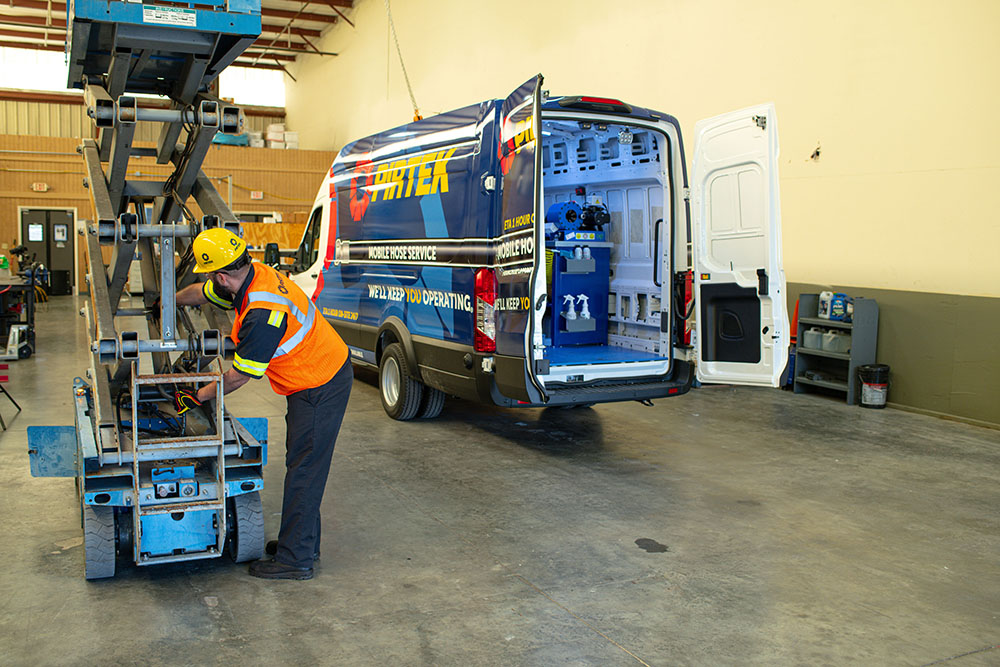Emergency Hydraulic Repairs Done Right: Techniques For Immediate Results

Hydraulic system failures can halt entire production lines, causing thousands of dollars in losses every hour. These unexpected breakdowns demand swift, precise emergency hydraulic repairs to minimize downtime and prevent cascading equipment damage. PIRTEK specializes in replacing hydraulic hoses on-site, providing a reliable and efficient alternative that ensures optimal system performance. Manufacturing plants, construction sites, and industrial facilities rely heavily on hydraulic systems for daily operations, making rapid repair capabilities essential for business continuity.
Professional hydraulic system maintenance and emergency repair protocols help organizations effectively address these critical situations. From emergency hydraulic hose repair to comprehensive maintenance of pneumatic and hydraulic systems, proper techniques and procedures ensure immediate results while maintaining safety standards. This guide examines proven diagnostic methods, rapid response protocols, and critical component repair techniques that teams can implement during hydraulic emergencies. Readers will learn essential strategies for both immediate fixes and long-term solutions to prevent future failures.
Emergency Hydraulic System Diagnosis
Effective diagnosis forms the cornerstone of successful emergency hydraulic repairs. A systematic approach to troubleshooting helps maintenance teams identify issues quickly and accurately, ensuring appropriate repair strategies are implemented.
Visual Inspection Techniques
Visual inspection serves as the first line of defense in hydraulic system diagnosis. Technicians should conduct a thorough external examination while following proper safety protocols. Key inspection points include:
- Checking for visible fluid leaks around fittings and connections
- Examining hoses for signs of wear, bubbling, or fraying
- Inspecting rod conditions for corrosion and pitting
- Evaluating pipe connections and system components
- Monitoring system temperature using infrared devices
Safety Note: Technicians should never use their hands to check for leaks, as high-pressure fluid can cause severe injection injuries.
Pressure Testing Methods
Pressure testing provides crucial data about system performance and integrity. The process typically involves filling the circuit with hydraulic fluid and gradually increasing pressure while monitoring various parameters. During testing, technicians measure pressure at multiple points to identify abnormalities or discrepancies from recommended ranges.
A comprehensive pressure test includes monitoring the system for 15 minutes at maximum pressure while checking for leaks at connection points. Critical measurements include pump outlet pressure, return line pressure, and pressure drops across significant components.
Common Failure Patterns
Understanding typical failure patterns helps expedite the diagnostic process. Most hydraulic system issues fall into two primary categories: pressure-related and volume-related problems. Pressure issues often manifest as insufficient force to operate equipment, while volume problems typically result in slower operation or erratic movement.
Cavitation, identified by a distinctive high-pitched whining sound, indicates potential pump problems. System overheating frequently points to issues with coolers or relief valves, while aeration-related problems manifest through unusual noise patterns and decreased system efficiency. Regularly monitoring these patterns helps prevent catastrophic failures and enables proactive maintenance scheduling.
Rapid Response Repair Protocols
Responding swiftly to hydraulic emergencies requires a structured approach that prioritizes safety while enabling rapid system recovery. Maintenance teams must follow established protocols to prevent further damage and ensure safe repair operations.
Initial Safety Measures
The first response to any hydraulic emergency must focus on personnel safety and equipment protection. Critical safety measures include:
- Clearing the affected area of non-essential personnel
- Ensuring proper personal protective equipment (PPE), including face shields and gloves
- Identifying and removing potential ignition sources
- Deploying spill containment materials
- Establishing a safe perimeter around the affected equipment
Emergency Shutdown Procedures
Emergency shutdown systems (ESD) are vital in preventing catastrophic equipment failure. When activated, these systems automatically initiate a controlled shutdown sequence to protect both personnel and machinery. The ESD system monitors critical parameters such as pressure, temperature, and fluid levels, triggering automatic responses when preset limits are exceeded.
Technicians must verify the complete depressurization of the system before attempting any hose replacements. This includes releasing stored energy in accumulators and ensuring all system components have returned to a safe state. Temperature monitoring is essential during this phase, as hydraulic fluid can reach dangerous levels exceeding 180°F (82°C).
Quick Assessment Guidelines
Rapid evaluation of the hydraulic system’s condition enables maintenance teams to determine appropriate repair strategies. Technicians should first identify the failure type – whether pressure-related or mechanical – and assess the extent of the damage. Visual indicators, system performance data, and operational history provide valuable insights for quick diagnosis.
During the assessment phase, maintenance personnel must document all observations and measurements. This information proves crucial for both immediate repairs and future preventive maintenance planning. System pressure testing may be necessary but should only be conducted after confirming the integrity of all components and connections.
Critical Component Repairs
Successful emergency hydraulic repairs depend heavily on properly maintaining and replacing critical components. Maintenance teams must be equipped with the right tools and knowledge to address various component failures efficiently.
Hose and Fitting Replacements
Emergency hydraulic hose repair requires precise attention to compatibility and proper installation procedures. Technicians should utilize field repair kits that include various sizes (1/4″, 3/8″, 1/2″) to accommodate different system requirements. Critical safety note: All repairs must begin with complete system depressurization and proper containment of residual fluid.
The replacement process includes:
- Cleaning the affected area thoroughly
- Measuring precise hose specifications
- Selecting compatible fittings
- Installing proper torque specifications
- Testing at low pressure before full operation
Seal and Gasket Solutions
Seals play an indispensable role in maintaining system pressure and preventing contamination. Quality and appropriately chosen seals are the primary defense against leaks, ensuring optimal system performance. When addressing seal failures, technicians must consider the following:
|
Seal Types |
Applications |
Replacement Frequencies |
|
Rod Seals |
Cylinder Protection |
Based on wear patterns |
|
Wipers |
Contamination Prevention |
During system overhaul |
|
O-rings |
Connection Sealing |
Signs of degradation |
Pump and Motor Emergency Fixes

Common emergency fixes include:
- Addressing cavitation through proper fluid levels
- Correcting aeration issues in the system
- Managing contamination through filtration
- Implementing temporary pressure adjustments
Technicians must maintain detailed documentation of all emergency repairs, noting specific components replaced and any temporary solutions implemented. This information proves invaluable for scheduling permanent repairs and preventing future failures through predictive maintenance strategies.
Temporary vs. Permanent Solutions
Making informed decisions about hydraulic system repairs requires understanding the distinction between temporary fixes and permanent solutions. Maintenance teams must carefully evaluate each situation to determine the most appropriate approach while considering both immediate needs and long-term reliability.
Quick-Fix Techniques
Temporary repairs serve as crucial stopgap measures during emergency situations. These solutions typically involve using hydraulic hose clamps, sealants, or specialized tapes designed for high-pressure applications. While effective for immediate crisis management, these fixes come with specific limitations:
- Maximum pressure tolerance of 2000 PSI
- Limited durability under continuous operation
- Required frequent monitoring for potential failures
- Necessity for planned permanent repairs
Long-Term Repair Planning
Proactive maintenance strategies significantly reduce the overall cost of hydraulic system operation. A well-developed maintenance plan includes:
|
Aspects |
Short-Term Fixes |
Permanent Solutions |
|
Cost Impact |
Lower initial cost |
Better long-term value |
|
Downtime |
Minimal immediate |
Planned maintenance |
|
Reliability |
Limited duration |
Extended lifespan |
|
Safety Factor |
Requires monitoring |
Enhanced security |
Professional hydraulic services play a vital role in implementing permanent solutions. Regular maintenance partnerships help prevent inflated repair costs and reduce hours of unexpected downtime.
When to Choose Each Approach
The decision between temporary and permanent solutions depends on several critical factors. Emergency hydraulic repairs might require quick fixes when:
- Production deadlines are imminent
- Replacement parts are unavailable
- Immediate cost constraints exist
- Environmental conditions prevent permanent repairs
However, maintenance teams should transition to permanent solutions as soon as feasible. This approach involves proper component replacement, professional crimping of hydraulic hoses, and comprehensive system testing. The implementation of effective preventative maintenance programs extends equipment lifespan and mitigates the risk of future emergencies.
Professional hydraulic maintenance services offer distinct advantages through their expertise, specialized equipment, and ability to provide warranty-backed repairs. These services ensure that both temporary fixes and permanent solutions meet industry standards while maintaining system integrity and operational safety.
Conclusion
Proper emergency hydraulic repairs demand both technical expertise and strategic planning. Maintenance teams must master systematic diagnosis protocols while prioritizing safety measures to prevent further system damage. Quick fixes are essential during critical situations, though permanent solutions through professional services provide long-term reliability and cost efficiency.
Successful hydraulic system maintenance combines thorough component knowledge, proper repair techniques, and strategic decision-making between temporary and permanent solutions. Regular monitoring, documentation, and preventive maintenance help organizations avoid costly emergencies and extend equipment lifespan.
This comprehensive approach to hydraulic system maintenance empowers organizations to minimize downtime, protect valuable equipment, and maintain optimal operational efficiency. Professional hydraulic services, combined with well-trained maintenance teams, create robust systems that withstand demanding industrial applications while meeting strict safety standards.
If your company ever has a hydraulic hose failure, call PIRTEK USA. Whether it’s day or night, PIRTEK USA’s 24/7/365 On-Site Mobile Hose Service is ready to fix your hydraulic hose emergencies.
FAQs
Q: What are the five steps to diagnose a hydraulic system that isn’t building pressure?
A: To effectively troubleshoot a hydraulic system that isn’t building pressure, follow these steps:
- Understand the issue by familiarizing yourself with the hydraulic pump’s connection to the more extensive system.
- Ensure all hydraulic connections are secure and properly installed.
- Compare the performance of malfunctioning units to those that are functioning correctly.
- Conduct tests on the system to identify any discrepancies.
- Always use the appropriate tools for troubleshooting and repairs.
Q: What steps are involved in changing a system’s hydraulic fluid?
A: Changing hydraulic fluid involves several key steps:
- Prepare the area and gather the necessary tools and materials.
- Drain the old oil and inspect the residue left at the bottom of the tank.
- Check the interior of the tank for any signs of wear or damage.
- Inspect the filters’ interiors.
- Make necessary corrections and clean the components.
- Seal the tank properly.
- Replace the filters.
- Refill the system with new hydraulic oil.



